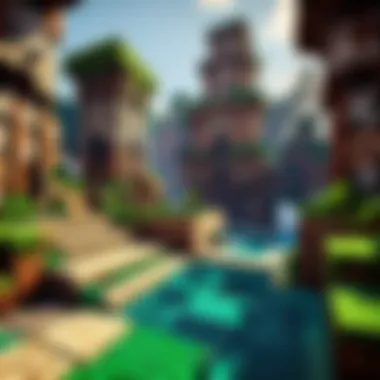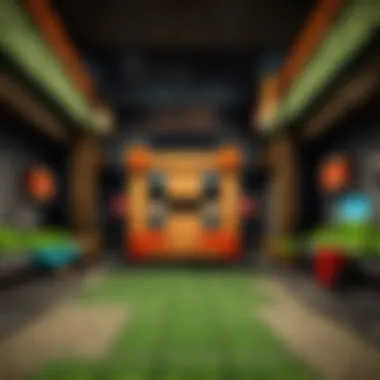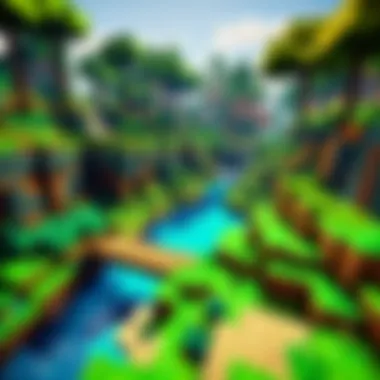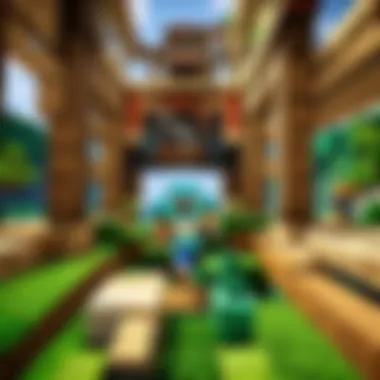Exploring Minecraft Mini Games: A Comprehensive Guide


Intro
Minecraft continues to hold its place as a prevalent cultural phenomenon. One of its most engaging features is the array of mini games, which enrich the gaming experience. These mini games offer players a respite from the main game and encourage creativity. By exploring how these games operate, we can appreciate their role within the Minecraft community. Furthermore, understanding various strategies for play can enhance one's skills, whether for casual fun or competitive play.
Minecraft Game Guides
Overview of Mini Games
Mini games in Minecraft turn traditional gameplay into unique challenges. They range from parkour courses to combat arenas, allowing player creativity to shine and their problem-solving skills to be tested. Let's delve into foundational knowledge for new players.
Character Creation Guide
Understanding how to use skin customization is essential. Players can create unique identities that mirror their styles. Communities thrive due to this personalization, sparking social interactions.
Building Techniques Tutorial
Specific building techniques apply directly in mini games. In Spleef, for example, constructing with careful terrain manipulation leads to strategic advantages. Techniques such as scaffolding and rapid block placing can give players extreme advantages in competitive environments.
Redstone Mechanics Explained
Redstone is pivotal in many mini games. Its mechanisms can affect the game's pace and user interaction. Understanding redstone contraptions, such as traps and logic gates, aids in designing clever game elements or other players’ traps.
Crafting Recipes Encyclopedia
Certain mini games utilize crafting recipes skillfully. Events like Hunger Games require resourceful players. Understanding recipes allows players to create weapons, armor, and essential tools quickly.
Game Mechanics and Strategy
Understanding game mechanics is crucial for any mini game. Engaging in various mini games steadily builds one's skill.
Popular Mini Games
- Deathrun: Navigate obstacles and evade opponents.
- SkyWars: Compete to be the last player alive on floating islands.
- Bed Wars: Guard your bed while attempting to destroy others'.
Simple Strategies for New Players
- Know the Map: Familiarize yourself with exploration tasks to succeed early.
- Mini Game Etiquette: Respect others to create a wholesome environment.
A player's engagement level often rises drastically through adept participation in mini games. The balance between challenge and enjoyment can create lasting entertainment.
Community Engagement in Mini Games
Interacting with others is rewarding. Many players form deep connections via mini games on platforms like Reddit or Facebook. Such engagement elevates the importance of effective communication. Communities build around shared experiences, adding depth to the gaming world for everyone.
Creative Freedom in Mini Games
The allure of mini games lies not prevalent just in gameplay, but also creativity. Players often design their mini games, leading to innovative concepts and challenges that grow sustantiation. Hosting game events within the community motivates sharing unique mini experiences.
In sum, Minecraft mini games blend fun, strategy, and creativity. Familiarity with styles, mechanics, and community interactions uplifts skill, providing an enriching experience for both new and seasoned players alike.
Intro to Minecraft Mini Games
Mini games in Minecraft have emerged as an engaging facet of the game that enhances player interaction, creativity, and strategy. These condensed gameplay experiences allow players to enjoy a variety of challenges within the framework of Minecraft's vast virtual worlds. In this article, we will uncover fundamental aspects of Minecraft mini games, their evolution, types, and strategies for both casual play and competitive environments. Understanding the introduction to mini games provides context about their significance in enriching the core experience of Minecraft.
Understanding Mini Games
Mini games are essentially smaller, self-contained gameplay modules that deviate from Minecraft’s traditional gameplay style. They are characterized by specific objectives, rules, and challenges, typically designed for multiplayer interactions. Popular examples of these may include
- Spleef
- Capture the Flag
- Parkour Challenges
These games often emphasize skills such as teamwork, strategy, and quick reflexes. This dynamics enhance the collective gaming experience, making mini games appealing to players of various skill levels.


Mini games generally feature set rules and errors. Participation might require an understanding of the game's core objectives along with maintaining in-game efficiency and strategy to tackle problems. Their unique characteristics allow miners from various backgrounds to find something that crystallizes their interest in the gameplay.
The Rise of Mini Games in Minecraft
The rise of mini games in Minecraft signifies an adaptive gaming culture. Initially, players focused on building and exploration. However, as the community grew, so did their creativity and desire for competitive play. This transition was fortuitous, as it coincided with the introduction of more complex server functionality, allowing players to create independent game mechanics.
As communities began forming around mini games, they quickly gained traction. Events, tournaments, and game nights became frequent. Hunger Games, for instance, developed into a well-known mini game influenced by the popular book series, drawing players into its compelling and interactive survival format.
This continuing focus on mini gaming resonates not just in servers, but even contributes to master's players' game mastery without significant context distractions. Collectively caring venues where gamers easily reach out, form teams, and enjoy together led not just to renaissance of old players but nurtured new ones also.
Types of Minecraft Mini Games
The realm of Minecraft mini games is diverse, reflecting the creative spirit of its players. In this section, we explore the various types of mini games available. Understanding these different categories helps players choose games that align with their interests and skill levels. Each type of mini game offers unique gameplay experiences, enhancing the overall enjoyment of Minecraft. Benefit includes developing skills, making friends, and increasing overall creativity.
PvP Battle Games
PvP Battle Games, or Player versus Player games, are intense and thrilling.They test skills and strategies against other players. Popular examples include Hypixel's Bed Wars and Murder Mystery.
These games are fast-paced, often requiring quick reflexes and strategic thinking. The competitiveness elevates the gaming experience, and players gain a sense of achievement. Participating in such games can improve one's gameplay techniques, tactical awareness, and adaptability. Being aware of map layouts and resource locations also significantly benefits a player in PvP situations.
Parkour Challenges
Parkour challenges focus on jumping and navigating obstacles. They are designed to assess a player’s agility and precision. In many ways, parkour serves as a fundamental skill in Minecraft, enhancing overall player movement. Gamers will find their skills improved in performing jumps precisely and executing quick turns.
Notable parkour maps include parkour from The Hive and various custom server maps available worldwide. Players often participate solo or compete for the best time with others. This element introduces not just challenge, but also motivates players to keep practicing their routes. It emphasizes patience and perseverance, two essential traits in gaming.
Puzzle and Escape Rooms
Puzzle games engage the intellect. They can range from clue-based maps to elaborate escape rooms requiring logic and teamwork. Successful completion often hinges on the ability to think critically and collaborate effectively. Some standout maps available include The Lift and MisDeep Escape. Another aspect of these games is that they adapt to various difficulty levels which can cater to different competency levels of gamers.
By engaging in these mini games, players hone problem-solving skills and learn to work under pressure. Players experience the thrill of deciphering clues and learning to recognize patterns—all crucial skills valuable both in and out of Minecraft.
Adventure Maps
Adventure maps provide a story-driven gaming experience. They challenge players to complete quests, often within a guided narrative. A well-designed adventure map will encourage exploration and creativity, making use of Minecraft's vast assets. Well-known examples include The Arid Kingdom and The Lost Potato.
These maps focus on progression through story elements and challenge. Players often find themselves thinking critically about paths to take, resource management, and conflict resolution within stories.
Survival Games
Survival Games emphasize endurance, strategy, and resource management. The gameplay often mimics battle royale formats, where players compete against one another in limited environments. A classic example of this is Hunger Games, which is both famous and provides deep experience through survival mechanics. Players often gather resources, build shelters, and ultimately fight for existence in the final rounds.
This game type is effective for developing strategic thinking skills. Beginners might find the strategic aspect fairly challenging, but longevity makes players much more adept than initially.
Mod-Based Mini Games
Lastly, mod-based mini games leverage Minecraft's extensible nature, allowing creators to add custom features not present in the base game. Mods can introduce new mechanics, themes, and challenges. Some preferred examples include Walls and Skyblock advancements. Proper understanding of mods can extend playability and open new avenues for enjoyment.
A gradual adaptation to these mod games involves learning the mod mechanics and understanding their synergy with standard Minecraft features.
With these various types of mini games, Minecraft provides players multitude pathways to explore, each catering to different skill sets and preferences. The enjoyment stems from not only playing but finding one’s niche, leading to continual growth within the Minecraft ecosystem. Players connect with others through their shared popularity, which reinforces community engagement.
Popular Minecraft Mini Games
The realm of Minecraft mini games thrives on creativity and player engagement. They provide an avenue for not only competition but also collaboration. Popular mini games have several advantages. They create communities around shared experiences. Often, players return to familiar games that evoke fond memories of play. Each game mentioned below demonstrates unique mechanics and rules, shaping the gaming landscape.
Hunger Games
Hunger Games gained popularity through its clear premise based on survival. Players start unarmed in an arena declared by the host. Their challenge is to gather resources, craft weapons, and eliminate competitors while managing hunger levels. Often depicted in a sprawling landscape, players must navigate a deadly environment filled with traps and surprises. The game rewards strategy and stealth, becoming more intense as elimination decreases player numbers.
The essence of Hunger Games is survival, decre (Harry), built around both pressure and tactics.


SkyWars
SkyWars introduces a vertical, aerial format to Minecraft mini games. Here, players spawn in separate sky islands. The goal is to eliminate adversaries while scavenging for resources hidden in chests. Navigation across islands is critical. Players often get creative, developing strategies involving building bridges, circumventing opponents, or exploiting elements like the void. A well-executed plan can outplay raw aggression, tying skill to unique enhancements offered by different maps.
Bed Wars
In Bed Wars, cooperation plays a vital role. Teams of players defend their beds while attempting to destroy those of opponents. The unique gameplay mechanics foster team-based strategies and resource management. Upgrading weapons and armor adds depth to the experience, often leading to surprise dynamic tactics in battle. This game commands devotion as players appreciate both strategic defense and clever offense.
Spleef
Spleef entertains with its simple ruleset yet promises thrilling competion. Players must break blocks beneath their foes as they try not to fall. Success hinges on split-second timing and spatial awareness. The simplicity opens appeal to a broad audience while cultivating a fierce competitive edge among skilled players. Through various levels of Spleef maps and formats, unique challenges ensure ongoing excitement.
Capture the Flag
In Capture the Flag, teamwork is core. Divided into two teams, players aim to capture the enemy’s flag while defending their own. Coordination is vital; players must effectively communicate to strategize attacks and defenses. Various approaches characteristically blend offensive strategies with humorous instances of betrayal or heroism. The game thrives on action, but the connection with others distinguishes it in the broader Minecraft landscape.
Each of these mini games contributes to the diversity within the Minecraft environment. They uphold essential values while provoking enjoyment and challenge. Understanding these popular games can only enrich a player's experience within this vast universe.
Creating Your Own Mini Game
Creating a mini game in Minecraft is a valuable process that opens doors to self-expression and innovation. It allows players to engage with the game on a deeper level, as they plot, design, and bring their ideas to life. Depending on individual preferences, mini games can adopt numerous formats, inviting players one step further into the realm of creativity. Furthermore, they often start as a personal challenge or a new way of gaming with friends, gradually potentially evolving into recognized experiences within the larger Minecraft community.
Essential Tools for Game Development
To embark on the journey of game development within Minecraft, specific tools enhance the process significantly. Understanding how to use these tools can make or break the experience. Here are some indispensable resources to consider:
- Minecraft itself: It is essential to have a strong grasp of the Minecraft mechanics. Exploring Minecraft deeply gives insight into possibilities.
- Command Blocks: Mastery of command blocks plays a crucial role. They facilitate various gameplay features, from teleportation to changes in game mode.
- WorldEdit: Efficient for building large maps and designs. This tool allows players to manipulate blocks quickly.
- Message mods: For maps that require specific directions or rules, modding can profoundly change how players interact with their environment.
These tools help streamline the development process and give players the hardore appproach needed to produce remarkable creations and features.
Game Design Principles
Designing a successful mini game entails fundamental principles whose application remains critical. Keeping these elements in mind will assist in honing skilled titles:
- Clear Objectives: The purpose of the mini game should never be unclear. Players should understand their goals from the start—whether it’s conquering a maze, collecting items, or outsmarting opponents.
- Balanced Mechanics: Gamers seek satisfying experiences. Attention to detail in game mechanics ensures every player has a fair chance.
- Replayability: Regardless of complexity, consider the mini game's potential for long-term interest. Engaging elements that foster desire for repeat play foster community engagement.
- Feedback Systems: Incorporate mechanisms that inform players of their progress, failures and successes. This can include various forms of notifications or scoreboard integrations, improving the overall player experience.
Testing and Iteration
Testing is often overlooked yet remains a vital step in creating mini games. First drafts rarely showcase products ready for widespread enjoyment. Prototype the game, allowing friends or community members to playtest it before official release. Here are key elements to focus on:
- Bug Finding: No game is perfect upon release. Finding and fixing bugs helps gamers avoid frustration.
- Gathering Feedback: Player feedback provides unique insights to refine gameplay. Ask direct questions and encourage critique to enhance the experience.
- Adjusting Difficulty: Depending on players’ responses, level adjustments may be necessary. Ideal challenges are neither intimidating nor overly simplistic.
- Continuous Iteration: Gaming remains an evolving process. Regular updates assist in keeping experiences dynamic, addressing player preferences, and fine-tuning game balance.
Creativity blends with methodical forever shifting elements when designing a Minecraft mini game. These foundational principles guide aspiring developers in crafting engaging yet enjoyable experiences. Always assess not only the mechanics but also the joy derived from play, as exceptional game generation builds upon fun.
"The essence of creating is not just structure, but the spirit of play and exploration that fuels the game."
Strategies for Success in Mini Games
Success in Minecraft’s mini games goes beyond mere luck. Understanding and mastering specific strategies can elevate one’s gameplay experience. This section focuses on important strategies that can help players not just participate, but truly excel in mini games, fostering personal growth and the joy of gaming.
Teamwork and Communication
In many mini games, especially those that are team-based, the importance of teamwork cannot be overstated. Effective communication allows players to share vital information, coordinate efforts, and formulate strategies in real-time. Teams that communicate clearly can execute complex tactics, leading to increased chances of success.
- Establish roles within the team to leverage each player's strengths.
- Use voice or text chat to share information instantly.
- Develop signals or shorthand to communicate useful strategies swiftly.
Communicating during gameplay creates synergy among teammates. When everyone is on the same page about objectives, their chance of success can increase significantly. Teams often share an expanded sense of achievement when they cooperate effectively.
Resource Management
Another critical aspect of success is adept resource management. Players need to understand how to utilize limited resources clearly to gain advantages. Effective resource allocation can mean the difference in both competitive and casual contexts. Players can employ specific strategies:


- Always be aware of inventory space and make decisions about which items or tools are essential.
- Collect and stockpile resources when opening moves in a game.
- Keep track of opponents’ resource usage to react intelligently.
Budgeting resources helps players stay efficient and increases sustainability in long-running games. Running short on critical supplies can lead to vulnerability against opponents.
Mastering Game Mechanics
Each mini game in Minecraft comes with its own set of mechanics that dictate how players interact with the world and each other. Grasping the rules and specific nuances associated with a mini game can markedly enhance gameplay. Here are some key pointers:
- Spend time understanding the rules before jumping into a game.
- Experiment with different tactics or approaches to learn the strengths and limitations of the game.
- Pay attention to details like cooldowns, timings, and best movements.
Developing a deep understanding of the mechanics is not just beneficial for gameplay; it can also nurture quick adaptability. Knowing how to manipulate the in-game environment to your advantage is invaluable.
Understanding and applying these strategies can be critical to mastering Minecraft mini games. Taking time to develop teamwork, manage resources wisely, and hone mechanics can ensure enjoyment and a path to victory.
Community and Competitive Scene
The community and competitive scene surrounding Minecraft mini games plays a crucial role in shaping the overall experience of players. These aspects foster engagement, cultural expression, and personal growth among participants. Importantly, they help forge strong connections within a vibrant player base that actively contributes to the constant renewal of Minecraft’s immersive landscape.
Tournaments and Events
In the realm of Minecraft mini games, tournaments and events stand out as major highlights. They serve as platforms where players can demonstrate their skills in front of judges and enthusiastic spectators. Many of these competitions emphasize collaboration and are structured around specific mini game modes, such as SkyWars or Bed Wars.
Participation in tournaments offers significant benefits:
- Skill Development: Engaging in competitive play can improve individual game mechanics and strategies. Players are often pushed to think critically and adapt quickly against formidable opponents.
- Community Recognition: Achievements in tournaments can elevate a player's status in the community. Recognition often leads to more opportunities, including collaborations and streams.
- Networking Opportunities: Events cultivate connections between competitors, modders, and enthusiasts, enhancing the fabric of the community.
Hosting regular mini game events can also lead to increased participation, creating a cycle where new players are introduced constantly, boosting Minecraft's longevity.
Streaming and Content Creation
The rise of streaming platforms, such as Twitch and YouTube, has impacted how mini games are experienced. Many players now choose to share their gameplay through live streams or recorded content. These mediums not only allow for creating an engaging viewing experience but also help define the meta around popular mini games.
Factors to consider when entering streaming or content creation include:
- Audience Engagement: Successful content creators know their viewers. Interaction strengthens community ties and fosters a more positive environment where feedback is paramount.
- Content Diversity: Showcasing a variety of mini games keeps potential viewers interested. This dynamic encourages players to explore different facets of Minecraft and share experiences.
- Collaboration: Joining others in content creation, whether through cooperative gameplay or competitive showdowns, brightens the experience greatly for all involved. Shared audiences can accelerate growth for both parties.
Creators can have significant influence on budding players. They provide strategies, share insights, and even inspire the creation of custom mini games.
Building a Community Around Mini Games
Finally, nurturing a healthy community centering on Minecraft mini games has profound implications for player enjoyment. Developers should emphasize inclusivity, active engagement, and positive experiences.
Key aspects in fostering this type of community include:
- Communication Channels: Platforms like Discord or Reddit provide spaces for announcements, discussions, and problem-solving.
- Regular Updates: Keeping games fresh through patches, seasonal events, and player feedback keeps the excitement alive.
- Social Media Presence: Utilizing social media to share memes, highlights, and successes strengthens a sense of belonging.
“A well-cultivated community enhances everyone's experience in Minecraft. The joy of playing together makes mini games more than just competitions; they become shared memories.”
Culmination
The conclusion section serves as a pivotal ending to the exploration of Minecraft mini games. It encapsulates the key insights derived throughout this article and examines the elements, benefits, and considerations that affect both players and creators.
The Future of Minecraft Mini Games
The future of Minecraft mini games appears bright and full of potential. As Minecraft pushes updates and evolves, it creates a fertile ground for innovation. We are seeing a constant influx of new ideas from the community. Developers continue to create novel game modes, utilizing tools like command blocks and data packs that expand gameplay options. This creative trend means that mini games are becoming more intricate and varied, offering exceptional experiences for players.
Moreover, looking ahead, players can expect more cohesive and organized events. This involves tournaments and competitions increasingly gaining popularity. Additionally, community-run events will form a crucial part of the ecosystem, offering players a chance to engage and prove skills against each other.
Community engagement will foster teamwork, competition, and social interactions—three key aspects that make these mini games successful.
One cannot overlook the influence of streaming platforms like Twitch. As more content creators share mini games with their audiences, familiarity grows. Younger players may feel encouraged to join the community and explore these games further. Thus, the cycle of interest and participation continues, leading to further advancements.
Final Thoughts
As analyzed in this guide, Minecraft mini games occupy a significant space within the broad universe of the game. They offer unique formats, compelling challenges, and a rewarding way to utilize Minecraft's versatile mechanics. Embracing these mini games not only adds variety to gameplay but also enhances community ties among players of diverse backgrounds and skills.
In summation, mini games manifest an essential aspect of the Minecraft gameplay experience. They invite creativity, strategy, and competition in a digestible format. Therefore, both existing players and newcomers should explore this engaging branch of Minecraft, empowering themselves through play and fostering profound connections within the vibrant gaming community.



